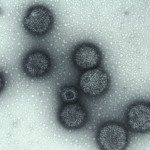Intervirology 2017;60:8-18
Emerging Flaviviruses pose an increasing threat to global human health. To date, human vaccines against yellow fever virus (YFV), Japanese encephalitis virus (JEV), dengue virus (DV), and tick-borne encephalitis virus (TBEV) exist. However, there is no human vaccine against other Flaviviruses such as Zika virus (ZIKV) and West Nile virus (WNV). In order to restrict their spread and to protect populations against the diseases they induce, vaccines against these emerging viruses must be designed. Obtaining new live attenuated Flavivirus vaccines using molecular biology methods is now possible. Molecular infectious clones of the parental viruses are relatively easy to generate. Key mutations present in live attenuated vaccines or mutations known to have a key role in the Flavivirus life cycle and/or interactions with their hosts can be identified by sequencing, and are then inserted in infectious clones by site-directed mutagenesis. More recently, the use of chimeric viruses and large-scale reencoding and introduction of microRNA target sequences have also been tested. Indeed, a combination of these methods will help in designing new generations of vaccines against emerging and reemerging Flaviviruses.


